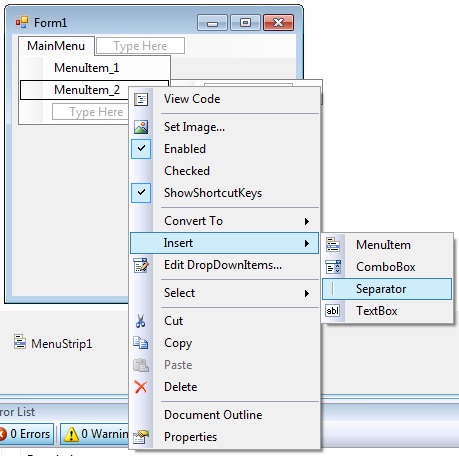

Below are some of the most noteworthy: Important ToolStrip Companion Classes Name The ToolStrip control's flexibility is achieved through the use of a number of companion classes. Raised when the Renderer property changes. Gets or sets the painting styles to be applied to the ToolStrip. Gets or sets a ToolStripRenderer used to customize the appearance and behavior (look and feel) of a ToolStrip.

Gets the ToolStripItem that is the overflow button for a ToolStrip with overflow enabled.

Gets a value indicating whether a ToolStripItem displays other items in a drop-down list when the ToolStripItem is clicked. Gets or sets whether a ToolStripItem is attached to the ToolStrip or ToolStripOverflowButton or can float between the two. Gets or sets a value indicating how the ToolStrip lays out its items. Gets or sets a value indicating whether drag-and-drop and item reordering are handled privately by the ToolStrip class. Gets or sets which edge of the parent container a ToolStrip is docked to. Below are some noteworthy members: Important ToolStrip Members Name The ToolStrip control is highly configurable and extensible, and it provides many properties, methods, and events to customize appearance and behavior. You can extend the functionality and modify the appearance and behavior by using the ToolStripRenderer, ToolStripProfessionalRenderer, and ToolStripManager along with the ToolStripRenderMode and ToolStripManagerRenderMode enumerations. Use the ToolStripControlHost class to use other controls on a ToolStrip and gain ToolStrip functionality for them. Handle events consistently for all containers and contained items, in the same way you handle events for other controls.ĭrag items from one ToolStrip to another or within a ToolStrip.Ĭreate drop-down controls and user interface type editors with advanced layouts in a ToolStripDropDown. Support the typical appearance and behavior of the operating system through a common rendering model. The overflow feature moves items to a drop-down menu when there is not enough room to display them in a ToolStrip. Support overflow and run-time item reordering. Present a common user interface across containers.Ĭreate easily customized, commonly employed toolbars that support advanced user interface and layout features, such as docking, rafting, buttons with text and images, drop-down buttons and controls, overflow buttons, and run-time reordering of ToolStrip items. ToolStrip controls offer a rich design-time experience that includes in-place activation and editing, custom layout, and rafting, which is the ability of toolbars to share horizontal or vertical space.Īlthough ToolStrip replaces and adds functionality to the control in previous versions, ToolBar is retained for both backward compatibility and future use if desired.
#Vb net spaceer on menustrip windows#
The Windows Forms ToolStrip control and its associated classes provide a common framework for combining user interface elements into toolbars, status bars, and menus.


 0 kommentar(er)
0 kommentar(er)
